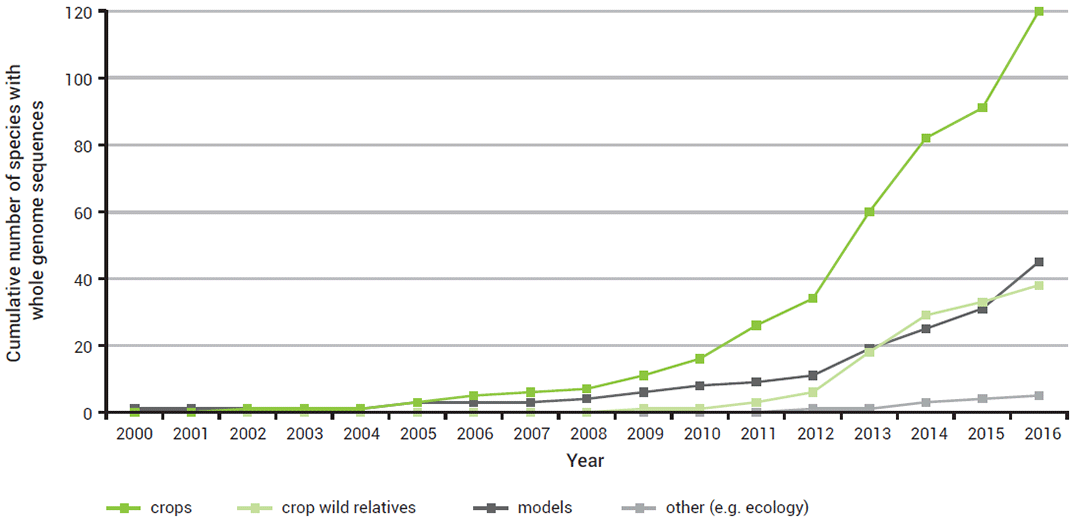Genetic diversity is of fundamental importance not only as the raw material for continued adaptation of wild species by natural selection, but also in maintaining and enhancing the diversity of cultivated plants and breeds of livestock underpinning the resilience of agricultural systems and food security (Khoury et al. 2014; FAO 2015a; Bruford et al. 2017). Conservation of genetic diversity can be implemented in situ in the wild or crop fields, or increasingly ex situ in gene banks and seed collections maintained at local and national levels (see Section 13.2.4).
Long-term declines in the number of varieties of crops and breeds of livestock continue, and much of this diversity, alongside that of wild relatives and lesser used species, still lacks sufficient protection (FAO 2015a). More than 35 species of birds and mammals have been domesticated for use in agriculture and food production, and there are about 8,800 recognized breeds (FAO 2018a). An assessment of extinction risk for existing local animal breeds found 65 per cent are classified as ‘status unknown’ because of missing population data or lack of recent updates, 20 per cent as ‘at risk’ and only 16 per cent as ‘not at risk’ (FAO 2018a). These proportions vary regionally, particularly with respect to the availability of data (Figure 6.9).
New genomic tools that allow rapid and increasingly low-cost DNA sequencing have become an integral part of conserving genetic diversity ex situ, helping us to understand the genetic potential of crop wild relatives for enhancing productivity, nutritional content and resilience to environmental change (Royal Botanic Gardens Kew 2016). As of 2017, some 225 species of plants, mostly crops, had complete genome sequences (Royal Botanic Gardens Kew 2017; see Figure 6.10). However, this remains an expensive enterprise and there is an ongoing need to share related information with those whose livelihoods are dependent on biodiversity but lack the resources to access such data.

Traditional approaches to breeding-enhanced varieties of plants and breeds of livestock still predominate; however, genetically modified (GM) organisms continue to draw attention and new advances, such as the CRISPR/Cas genome editing techniques, are advancing synthetic biology (SCBD 2015; CBD 2016). There is evidence of the positive contribution of genome-editing techniques through the control of invasive species (Webber, Raghu and Edwards 2015) due to the lessened need for insecticides that are harmful to non-target organisms (e.g. Li et al. 2015). However, the propagation of genomeedited crops may also contribute to negative biodiversity and environmental outcomes, such as facilitating the spread of herbicide-resistant weeds (Rótolo et al. 2015) and reduced insect diversity (Schütte et al. 2017; Tsatsakis et al. 2017), and the natural adaptation of ecosystems to GM traits may ultimately require further technological innovation and increased use of herbicides and insecticides (Rótolo et al. 2015).
The conservation status of genetic diversity for most wild species unrelated to agricultural crops and livestock remains poorly documented (although there are concerted efforts to close this gap, see http://www.genomicobservatories.org). Yet population declines are increasingly commonplace (Ceballos, Ehrlich and Dirzo 2017; McRae, Deinet and Freeman 2017). A loss in population size, particularly when persisting over several generations, frequently translates into a loss in genetic diversity. Thus, the drivers that threaten species and populations also likely erode the genetic diversity within them.